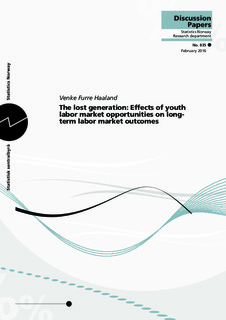| dc.contributor.author | Haaland, Venke Furre | |
| dc.date.accessioned | 2018-10-31T11:55:07Z | |
| dc.date.available | 2018-10-31T11:55:07Z | |
| dc.date.issued | 2016-02-04 | |
| dc.identifier.issn | 1892-753X | |
| dc.identifier.uri | http://hdl.handle.net/11250/2570364 | |
| dc.description.abstract | This study shows that local unemployment rates at the age of graduation from compulsory school and high-school have negative effects on males’ earnings, employment and disability pension when measured as late as age 35.
Utilizing registry data for all Norwegian males born in 1959–1973, I demonstrate that local unemployment rates at the typical age of graduation from compulsory school (age 16) and high-school (age 19) have persistent, negative effects on males’ earnings, employment, and disability pension utilization when measured as late as age 35. With data on every male IQ, I study how labor market conditions at age of graduation have differential effects for low- and high-ability males. As one would expect, low-ability males are particularly vulnerable to business cycles at the time of labor market entry. | nb_NO |
| dc.language.iso | eng | nb_NO |
| dc.publisher | Statistisk sentralbyrå | nb_NO |
| dc.relation.ispartofseries | Discussion Papers;No. 835 | |
| dc.subject | Arbeidsmarkedet | nb_NO |
| dc.subject | Menn | nb_NO |
| dc.subject | Ungdom | nb_NO |
| dc.subject | Arbeidsløshet | nb_NO |
| dc.title | The lost generation: Effects of youth labor market opportunities on longterm labor market outcomes | nb_NO |
| dc.type | Working paper | nb_NO |
| dc.subject.nsi | VDP::Samfunnsvitenskap: 200::Sosiologi: 220 | nb_NO |
| dc.source.pagenumber | 48 s. | nb_NO |
